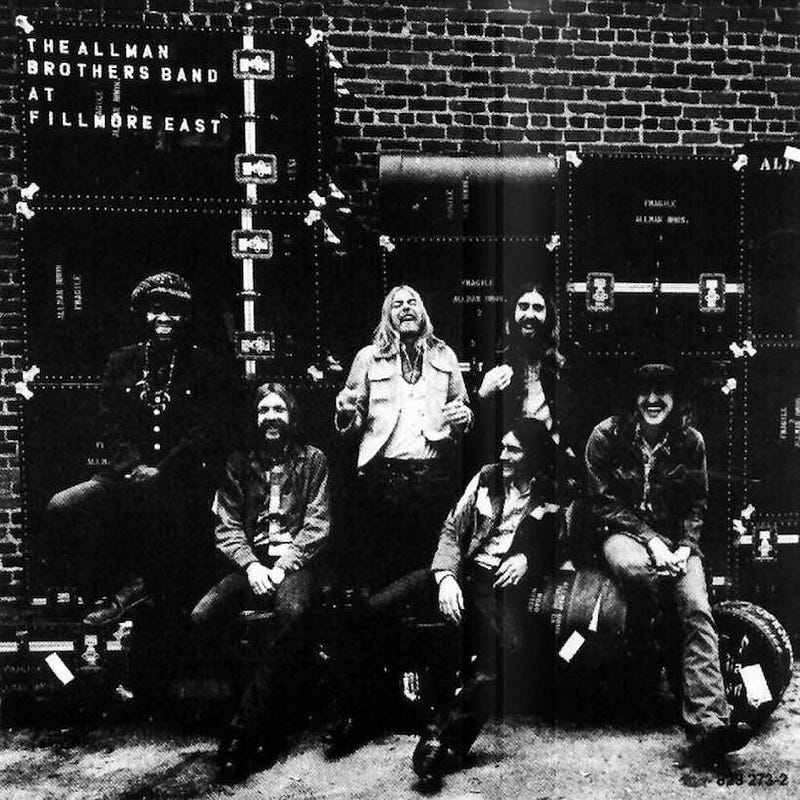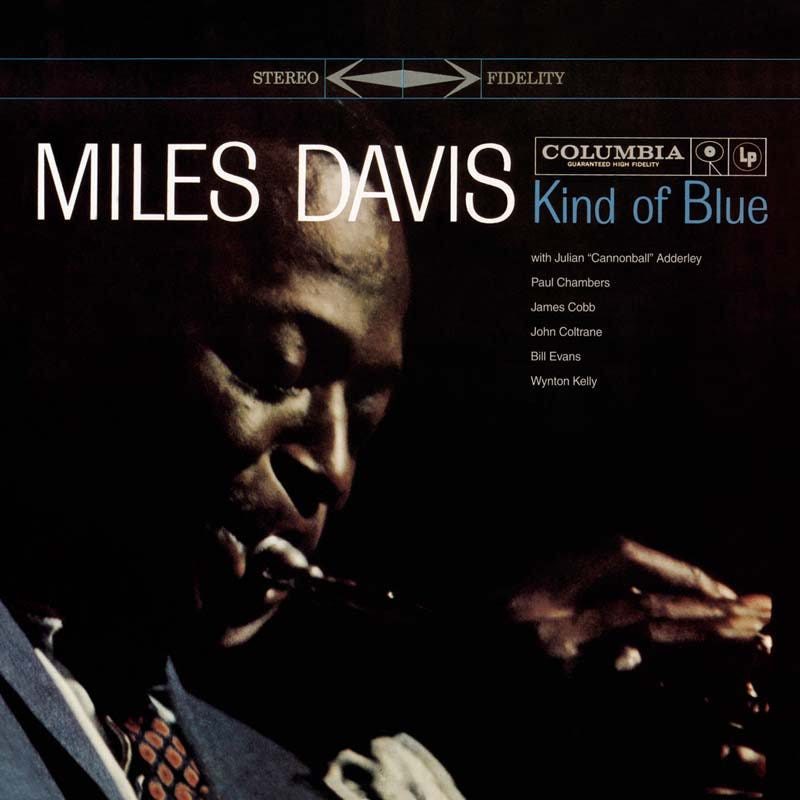Kind of Blue Is More than the Best-Selling Album in Jazz History
It was a major influence on the Allman Brothers Band 🍄
UPDATE MAY 2024: Pulling this one from the archives in honor of Miles Davis’s birthday May 26.
The dissertation is now a book, Play All Night! Duane Allman and the Journey to Fillmore East, which you definitely should have a copy of.
March 1, 2019 marked the 60th anniversary of one of the most important recordings in music history: Miles Davis’s Kind of Blue.
Writers have spilled tons of ink on the album and its impact on music. I found out about the anniversary from a link milesdavis.com shared: “Kind of Blue: The Jazz Album by Miles Davis that Transformed Music.”
To date, Kind of Blue remains the best-selling album in jazz history. And it’s a good bet that if a music lover only owns a single jazz record, it is this one. (I’ll leave out any commentary on only owning one jazz record!)
As I saw my friends post the link and mention their own experiences with the Miles Davis masterpiece (one of several Miles recordings that changed music history), I thought about the record’s influence on the Allman Brothers Band, whose founding I documented in my Ph.D. dissertation, “You Wanna Play in My Band, You Better Come to Play”: Duane Allman and American Music.
Here are some words I wrote in my dissertation about that album’s influence on the Allman Brothers Band. (Hint: It was not insignificant.)
—
From Chapter 5: “Strive to Play a Pure Form of Music; A Kind of Music that’s Honest to Yourself”: The Development of the Allman Brothers Band
“Dreams” is an interesting part of the Allman Brothers Band canon. Of their early compositions, it is the one that is most clearly jazz-influenced. Drummer Jai Johanny “Jaimoe” Johanson dubbed it “‘My Favorite Things’ with lyrics,” referencing the Rogers and Hammerstein tune from The Sound of Music that saxophonist John Coltrane had released in 1961. The waltz-time “Dreams” also closely mirrors “All Blues” from Miles Davis’s groundbreaking album Kind of Blue, from which Johanson derived his drum part. The tune reflects this in several ways, particularly in its gentle 6/8 rhythm and a long, improvised solo over a two-chord vamp. “Dreams,” Duane Allman opined, “is the effect that good jazz has had on us.”
“We all really got in the Coltrane together,” Gregg Allman noted, “which became a big influence, and that was because of Jaimoe.” “When we were first putting a group together,” Duane Allman shared, “We were listening to Jefferson Airplane and the Dead’s records. We were all kicking around down South, buying records out of the Kmart and taking them home and digging them. And [Johanson] comes along and says, ‘Well that’s cool — good, but check out what I got over here, this collection.’ They just turned us all around. We heard with them cats were doing. Knocked us out.” Davis’s Kind of Blue and Coltrane’s My Favorite Things were both band favorites. “It’s like the blues background was right in there,” Dickey Betts shared, “and then like Roland Kirk, Pharoah Saunders, and John Coltrane kind of gave my music that far-out effect, and then adding that blues thing makes it a little more soulful than your jazz music.” Jazz became the bar for the band’s musical aspirations. “Those [jazz] cats catch the flow, so it’s on a level man that — like if you can ever achieve, you’ll never be satisfied with nothing else,” Duane Allman said. “If you can get the music flowing out there, where you don’t have to listen to it, it just takes you away. That’s the way we try to do it. It’s what we want to get out of it.”
The band members’ other listening habits also influenced them, as reflected in the band’s repertoire, songwriting, and performances. Each member continued to mine his own influences and introduce them to each other. “We all dug this different stuff,” Gregg Allman remembered, “but then we all started listening to the other guys’ music. What came out was a mixture of all of it.” “Everybody had their records that they listened to and we just shared them,” Johanson recalled. “I had no idea who the Grateful Dead or the Rolling Stones were, though I had heard some of their songs on the jukebox. Butch turned me on to all that stuff. Dickey was into country and Chuck Berry. Duane, Gregory, Berry, and myself were the rhythm and bluesers.” B.B. King, Allman’s guitar playing inspiration for many years, remained in rotation, as did electric bluesmen Albert King, Junior Wells, and Elmore James; acoustic bluesmen Lightnin’ Hopkins, Blind Willie McTell, and Robert Johnson; rhythm and blues singers such as Ray Charles; and contemporaries like Eric Clapton.
— —

From Chapter 6: “I Mortgaged Everything for this Thing. I Believed in it that Much”: Phil Walden and Capricorn Records
As is his wont, Johanson highlighted the connection to jazz. “To me, our songs were stretched out in the studio and we were able to do more of that when playing live. You think about the records that King Curtis did or maybe back to the Woody Herman Band or Duke Ellington’s band; in those bands, various people took solos and the energy directed them to do so; it’s the same way with us in a live setting.” While recording At Fillmore East, he shared, “You went by what the song was dictating as opposed to thinking it out — ‘We’re gonna do two verses of this and then we’re gonna do an eight-bar or sixteen-bar solo.’”
The band’s jams, Betts remembered, followed a jazz formula. They were “structured to the point where we’d know who went first. But what was going to happen in the middle of it, we never knew.” The songs morphed accordingly, stretching timewise to whatever limits the band and soloist felt in the moment. When queried about song length, Johanson quoted John Coltrane. “With whatever amount of space you have to do something,” the saxophonist said, “that’s what you have and the ability to do that just shows the mastery of knowing what you’re doing, how to develop it and how to play a song.” It is the formula the Allman Brothers Band followed in 1971 at the Fillmore East.
— — -
From Chapter 9: “We Came Back to the Big House and It Was Truly a Home”: The Public History of the Allman Brothers Band
In a room just off their bedroom, [bassist Berry and his wife Linda] Oakley set up a seating area. Dubbed the “Casbah,” it was the house’s official music room. According to Kirsten West’s history of the home, “Linda and Berry designed the music room and Linda hitchhiked to Atlanta to get the stereo. She put Indian prints on the walls and made it a warm and comfortable haven.” The house had no television set and the Casbah became the place where people gathered and listened to music and talked. “At the Big House,” Gregg Allman wrote, “we listened to music all the time.” Blues remained on the turntable. It was supplemented by records by the band’s Capricorn label mates Cowboy; King Curtis’s Live at Fillmore West; and albums from artists as wide-ranging as John Hammond, the Staple Singers, Taj Mahal, Bob Dylan, and the Beatles. Jazz, courtesy of drummer Jai Johanny Johanson, seeped into the band’s listening. “Jaimoe turned all of us on to so much neat stuff. He gave us a proper education about jazz and got us into Miles Davis and John Coltrane. Kind of Blue was always on the turntable — (Duane) really got his head around that album — and he also seriously dug Coltrane’s My Favorite Things.”
Davis and Coltrane’s influence is most evident in the band’s breakthrough album At Fillmore East, something Robert Palmer documented in liner notes for a 1997 reissue of Davis’s Kind of Blue. “[T]he one group I never missed [at Fillmore East] . . . was the Allman Brothers Band. More specifically, I went to see their guitarist.” Duane Allman, Palmer wrote, was “the only ‘rock’ guitarist . . . who could solo on a one-chord vamp for as long as half an hour or more, and not only avoid boring you but keep you absolutely riveted. Duane was a rare melodist and a dedicated student of music who was never evasive about the sources of his inspiration.” Palmer wrote that Allman told him, “That kind of playing comes from Miles and Coltrane, and particularly Kind of Blue. I’ve listened to that album so many times that for the past couple of years, I haven’t hardly listened to anything else.’”
All text © 2018 Bob Beatty from the Ph.D. dissertation “You Wanna Play in My Band, You Better Come to Pick”: Duane Allman and American Music



Nooooo. I had a huge long comment and it's gone. Mannnnnnnn. Wtf. I left the app to go get a link and came back and my comments gone. Ugh. Anyway. I'll do the abridged version. My favorite living guitar player was also very inspired by Miles. That being Buckethead. So much so that Bucket was transcribing Miles in 9th or 10th grade! Most people think he's just a shredder but his 600+ albums say otherwise. You should check him out sometime. I don't really go for the shreddy stuff or the super heavy stuff but that's not all he does. There's PLENTY more to like besides that. Starting with this one he dedicated to Miles, called "Sketches of Spain(For Miles)" https://youtu.be/FVwgMvHFbP0?si=Suqrll_xoekCjYfR according to Les Claypool, Bucket is the best rythum player he's ever seen/heard and his pocket is deeper than anyone's. I don't doubt it, coming from Les. You should check him out sometime, Bob. Sketches of Spain(For Miles) is a good place to start 👍